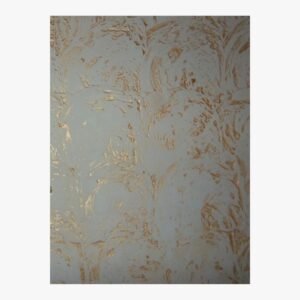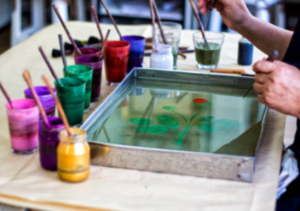Introduction to Texture Paint
Mithila Paints is a prominent player in the paint industry, known for its commitment to quality, innovation, and sustainability. Established in the early 2000s, the company has carved a niche in the production of high-quality paints, catering to both residential and commercial sectors. With a deep-rooted passion for art and craftsmanship, Mithila Paints draws inspiration from the rich cultural heritage of Mithila, a region in India renowned for its intricate art forms. This cultural influence not only sets the company apart but also reinforces its mission to integrate traditional art with modern technology.
The driving force behind Mithila Paints is its unwavering dedication to creating durable and aesthetically pleasing products. The company places a significant emphasis on research and development, ensuring that their offerings stay ahead of market trends and align with consumer expectations. By utilizing cutting-edge techniques and sustainable practices, Mithila Paints aims to minimize the environmental impact of their manufacturing processes. This commitment to innovation allows them to produce a diverse array of paints, including their specialized texture paints designed for ceilings, which combine functionality with artistic expression.
Mithila Paints’ mission extends beyond mere product manufacturing; it aspires to elevate the paint industry by fostering a culture of quality and responsibility. The company believes that every coat of paint should not only enhance the visual appeal of a space but also uphold the values of sustainability and ethical sourcing. Through its continued focus on excellence and customer satisfaction, Mithila Paints is positioned to lead the way in delivering exceptional products that resonate with consumers seeking both beauty and functionality in their interior design choices.

Understanding Texture Paint
Texture paint is a distinctive type of paint formulation designed to provide a textured finish to surfaces. Unlike standard paint, which results in a flat or glossy appearance, texture paint carries the unique capability of creating three-dimensional textures that can elevate an ordinary ceiling into a captivating focal point. This remarkable characteristic makes texture paint especially appealing for ceilings where aesthetic enhancement is desired.
The benefits of texture paint extend beyond mere aesthetics. One prominent advantage is its ability to conceal imperfections. Ceilings often exhibit various flaws, such as cracks, stains, or uneven surfaces. Texture paint, by virtue of its thick formulation and varied application methods, effectively hides these blemishes. Additionally, textured ceilings can help reduce the visibility of surface irregularities, allowing homeowners and designers to achieve a sleek appearance without extensive renovations.
Beyond imperfection concealment, texture paint contributes significantly to the overall atmosphere of a room. It can evoke different moods, depending on the texture and color chosen. For instance, a heavier, more rugged texture may impart a rustic, cozy feel, while a subtle, smoother texture can lend to a contemporary and sophisticated ambiance. This versatility allows for creative expression, enabling individuals to tailor their environments in accordance with personal preferences and requirements.
Moreover, the textured surface has practical benefits as well. It can improve the sound absorption properties of a room, creating a quieter and more pleasant space. Such features make texture paint a practical choice for various settings, including living rooms, dining areas, and even bedrooms. The combination of aesthetic appeal, the ability to hide imperfections, and the enhancement of room acoustics showcases why texture paint is particularly suited for ceilings. It transforms standard spaces into extraordinary environments, reflecting a blend of art and functionality.
The Manufacturing Process of Texture Paint
The manufacturing process of texture paint at Mithila Paints is a carefully orchestrated series of steps designed to ensure the highest quality product. The journey begins with the meticulous sourcing of raw materials, which are essential for formulating the texture paint. This includes pigments, binders, fillers, and additives, all of which are selected based on their performance characteristics and sustainability criteria. The commitment to using quality materials lays the foundation for excellence in the final product.
Once the raw materials are sourced, the next phase involves precise mixing. This step is crucial as it determines the color, consistency, and applicability of the texture paint. The ingredients are combined in calculated ratios using advanced mixing equipment to ensure a homogeneous blend. It is during this stage that Mithila Paints implements its innovative formulations, which contribute to the unique textures and finishes that the brand is known for.
Following the mixing process, the next step is milling. This operation involves grinding the mixture to achieve the desired particle size, which is critical for the texture paint’s application and finish. Effective milling promotes an even distribution of pigments and ensures a smooth texture, enhancing both aesthetic appeal and durability. Quality control is pivotal throughout this process; samples are tested to confirm that they meet the brand’s strict specifications.
Finally, a rigorous quality control procedure is implemented before the product is packaged. This includes testing for viscosity, drying time, and color consistency, ensuring that each batch of texture paint adheres to the highest standards set by Mithila Paints. By maintaining stringent quality assurance practices at every stage, Mithila Paints not only produces exceptional texture paints but also reinforces its reputation for quality craftsmanship in the industry.

Key Ingredients in Mithila’s Texture Paint
The formulation of Mithila’s texture paint is meticulously designed to ensure high quality, durability, and aesthetic appeal. A fundamental aspect of this process involves the careful selection of key ingredients, which can be broadly categorized into binders, pigments, and additives. Each component plays an essential role in imparting unique properties to the paint.
Binders are crucial in any paint formulation as they hold the pigments together and ensure adhesion to the surface. In Mithila’s texture paint, eco-friendly binders derived from natural sources are emphasized. These binders not only enhance the paint’s performance but also allow for a reduced environmental footprint. By using renewable resources, Mithila aims to align its practices with sustainable development while ensuring that the texture paint remains durable and long-lasting.
The color and vibrancy of Mithila’s texture paint is largely determined by its pigments. Natural pigments, which are integral to the Mithila art tradition, are chosen for their rich hues and permanent properties. These pigments not only contribute to the aesthetic quality of the paint but also ensure that the colors stay true and vibrant over time. The use of natural pigments embodies the cultural significance of Mithila art while enhancing the visual appeal of surfaces treated with this paint.
Additives play a pivotal role in the performance characteristics of Mithila’s texture paint. These components serve various purposes, including improving stability, enhancing the texture, and ensuring ease of application. For example, specific additives can improve the paint’s resistance to weather conditions, ensuring that the final surfaces maintain their integrity and beauty over extended periods. Moreover, the incorporation of eco-friendly additives aligns with the brand’s commitment to sustainability.
In conclusion, the thoughtful selection of ingredients in Mithila’s texture paint not only showcases the artistic heritage of Mithila but also promotes durability and environmental responsibility. By prioritizing natural materials, Mithila ensures that its texture paints not only beautify spaces but also contribute positively to ecological well-being.

Innovative Texture Techniques
Mithila Paints is renowned for its commitment to blending traditional artistry with modern innovation in the creation of texture paints for ceilings. The distinctive texture patterns that characterize Mithila Paints are achieved through a variety of innovative techniques that showcase not only the artistic flair of the artisans but also the effective use of advanced tools and equipment. One such technique involves the application of various layering methods, where multiple coats of paint are applied in succession to generate depth and complexity in the texture.
Artisans utilize specialized brushes, palette knives, and sponges to manipulate the texture of the paint during application. These tools facilitate the creation of intricate designs, such as swirling patterns reminiscent of traditional Mithila art, while also ensuring that each finish possesses unique characteristics. The artisans’ craftsmanship is paramount; their experienced hands know precisely how to blend colors and patterns to create a visual experience that captures and retains attention over time.
Furthermore, Mithila Paints has embraced technological advancements to refine its processes. The introduction of airbrush techniques has allowed for even greater precision in applying textures, bringing consistency to the results while maintaining the organic feel of hand-painted finishes. Additionally, the use of eco-friendly materials aligns with modern sustainability practices, ensuring that the innovative texture techniques are not only visually appealing but also environmentally responsible.
The interplay of technology and artistry is crucial in the production of Mithila Paints. The skilled artisans not only play a vital role in the application of these techniques but also contribute to the continuous evolution of the methods themselves. By pushing boundaries and exploring new possibilities, Mithila Paints continues to redefine what is achievable in texture painting, making it a standout choice for ceiling treatments that are both innovative and richly textured.
Quality Control Measures
Quality control is an essential aspect of the manufacturing process at Mithila Paints, particularly considering the growing demand for texture paints for ceilings. To ensure that each product meets stringent performance, consistency, and safety standards, Mithila Paints implements a multifaceted approach to quality assessment and control. This approach begins with the examination of raw materials sourced from trusted suppliers. The team at Mithila Paints meticulously evaluates these materials to guarantee compliance with the required specifications, which forms the foundation of superior products.
Once the production process commences, continuous monitoring becomes a crucial part of quality assurance. Throughout various stages of manufacturing, trained quality control personnel conduct regular inspections, focusing on key aspects such as viscosity, pigmentation, and texture. These inspections not only verify that the paint meets qualitative standards but also ensure that it retains the consistency expected in the final product. Unyielding adherence to industry regulations forms a critical component of Mithila Paints’ quality framework, assuring customers of the safety and efficacy of their texture paints.
In addition to in-house checks, Mithila Paints invests in advanced laboratory testing, where samples from each production batch are analyzed for performance metrics. This laboratory analysis assesses factors such as adhesion, washability, and durability, allowing for the identification of any potential flaws before the paint is ready for market release. Such stringent testing protocols demonstrate Mithila Paints’ commitment to quality, ensuring that every can of their texture paint meets high safety and durability expectations.
By maintaining these rigorous quality control measures, Mithila Paints assures customers that their texture paints for ceilings not only meet but often exceed industry standards. This unwavering focus on quality reinforces the brand’s reputation as a reliable choice for those seeking durable and aesthetically pleasing ceiling finishes.

Applications of Texture Paint on Ceilings
Mithila’s texture paint has gained popularity due to its unique traditional aesthetics and adaptability across various settings. One of its primary applications is in residential interiors, where homeowners are increasingly choosing textured ceilings to enrich their living spaces. The intricate designs found in Mithila art can elevate the ambience of a room, drawing attention to the ceiling and adding dimensionality. For instance, a vibrant texture can serve as a focal point in a dining area, while softer, subtler patterns lend a touch of elegance to bedrooms or living spaces.
Beyond residential applications, Mithila texture paint is also well-suited for commercial environments. Offices, restaurants, and retail spaces can benefit from the distinct character that textured ceilings provide. In offices, implementing such textures can promote creativity and evoke a sense of cultural appreciation, fostering an engaging atmosphere. Similarly, restaurants aiming for a unique dining experience often utilize Mithila textures to enhance their thematic decor, allowing patrons to feel immersed in a culturally rich setting.
Moreover, the artistic applications of Mithila texture paint are noteworthy. Many artists and designers leverage the material in their works to create captivating installations. By integrating traditional techniques and contemporary design principles, creative professionals can transform ceilings into artistic canvases that resonate with viewers. In galleries and exhibition spaces, textured ceilings can complement artworks, creating an immersive experience for the audience.
In conclusion, Mithila’s texture paint offers diverse applications that cater to different environments, enhancing both residential and commercial spaces while also serving as a medium for artistic expression. Its unique blend of traditional aesthetics and modern versatility makes it a valuable choice for designers and homeowners alike.
Customer Experiences and Testimonials
The use of Mithila Paints’ texture paint has garnered a positive reception from a diverse array of customers, ranging from homeowners to interior designers. One particular homeowner noted, “After applying Mithila’s texture paint in my living room, the transformation was remarkable. The intricate patterns not only added depth to the ceiling but also created a warm ambiance that I had hoped for.” This sentiment reflects the product’s ability to enhance the overall aesthetic appeal of home interiors, showcasing how texture paint can effectively elevate the design of any space.
Interior designers have also praised Mithila Paints for its versatility and ease of application. A designer mentioned, “Using Mithila texture paint allowed me to create custom designs that truly reflect my clients’ personalities. The variety of colors and textures enabled me to meet specific design objectives while ensuring a seamless finishing touch.” This insight underscores the product’s friendly usability, making it a preferred choice for professionals seeking reliable solutions for their creative projects.
Additionally, customers have consistently shared their appreciation for the durability of Mithila Paints’ texture paint. One user expressed, “It has been over a year since I applied the texture paint, and it still looks as vibrant as the day it was done. I am particularly impressed with how well it has resisted wear and tear.” This feedback illustrates the importance of selecting a high-quality product that promises longevity, further emphasizing Mithila Paints’ commitment to durable solutions.
Overall, the testimonials encapsulate the satisfaction derived from using Mithila Paints’ texture paint, highlighting its performance, aesthetic appeal, and positive impact on various interior projects. Such firsthand accounts provide valuable insight for potential customers considering texture paint for their own spaces.

Conclusion and Future Directions
The exploration of Mithila paints presents a fascinating blend of artistic tradition and scientific innovation. Throughout this blog, we have delved into the rich history and manufacturing processes that underpin Mithila paints. Traditionally rooted in the Mithila region of India, these paints reflect the cultural narrative of the area while also adapting to modern demands. The emphasis on natural ingredients has positioned Mithila paints as a leading choice for eco-conscious consumers seeking high-quality decorative solutions.
Looking ahead, the future of Mithila paints appears promising with several key directions that emphasize both creativity and sustainability. In the coming years, we anticipate the introduction of new product lines that not only enhance aesthetic appeal but also incorporate functional qualities suitable for various applications, including texture paint for ceilings. These innovations aim to cater to both residential and commercial needs, making Mithila paints a versatile option in the paint industry.
Moreover, advancements in manufacturing technology are expected to streamline production processes while ensuring that the uniqueness of Mithila art is preserved. Modern techniques could enhance the durability and finish of the paints, thus responding to consumer expectations for longevity and performance. Furthermore, the commitment to sustainability will remain at the forefront of our initiatives. Efforts to minimize environmental impact through responsible sourcing of materials and eco-friendly production methods will ensure the continued relevance of Mithila paints in a market increasingly attentive to ecological concerns.
In conclusion, as Mithila paints evolve, they will not only maintain their artistic heritage but will also adapt to contemporary trends in the paint industry. Emphasizing quality, creativity, and sustainability will be paramount as we navigate the future of this vibrant and tradition-rich craft.
